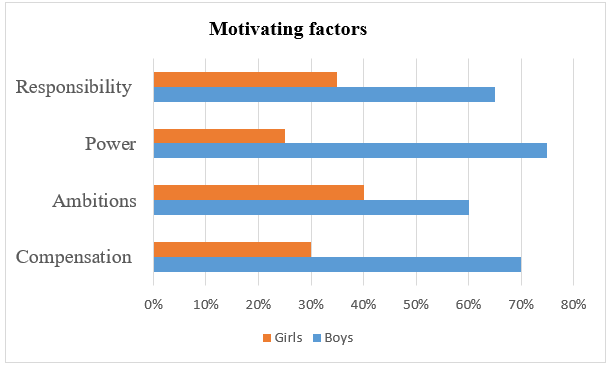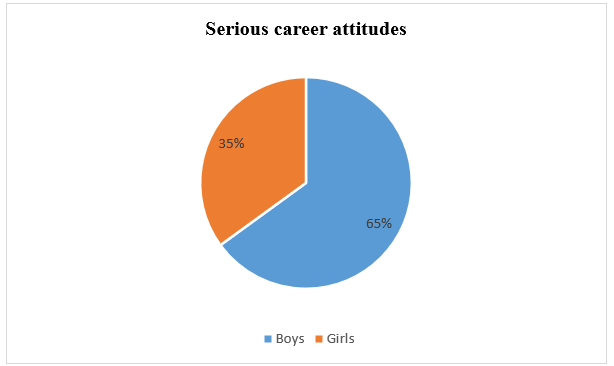Essay on Compare Boys’ and Girls’ Attitudes to Future Careers
Number of words: 1683
Introduction
In modern society, gender significantly impacts numerous career-related behaviors, results, and attitudes. This consists of work attitudes, career choices, occupational health, career experiences, and other related perceptions. In order to understand people’s careers, it is imperative to take into consideration the gender aspect. Boys and girls differ broadly when it comes to choosing a career, and various factors influence these variations. For instance, socialization experiences, which entail lifetime social learning skills that individuals possess when interacting with other people, is vital. School guidance counselors, teachers, parents, peers, siblings influence how people perceive themselves with regard to their gender (Watts et al., 2015, pg.10-22). The career choice process takes place all through the life cycle as people make choices that have work-related consequences. This study will try to establish whether any of the genders have a different attitude towards career choice.
Hypothesis
Presently, career choices have different to a significant extent, and both boys and girls strive for careers that mostly have been determined by society. Although each gender may choose careers pursued mainly by the other gender, the situation is not common. In most cases, boys will have a more serious attitude to future careers and aim for better-paying jobs as compared to girls.
Aims
This study will focus on the different attitudes boys and girls have toward the career choice process. This topic is relevant as it attempts to explain how both genders choose their future careers, and what factors affect their choices. Career choice is a vital decision it youths’ lives as it involves deciding what they will do for a living. One aim in this research is to investigate the aspiration for future careers in both genders. Usually, girls aim to acquire jobs such as media relations, public relations, events planning, health care, and writing. Ultimately, boys desire for careers such as engineering, legal, marketing, financial services, teachers, and executive management. Most boys aspire to become part of the management team in their future workplaces, which is a huge step as it differentiates them from their peers. Thus, boys aim for more challenging future careers, which would enhance their income level.
The alternative aim in this research is the perception of future income. Various individuals are motivated by money in their jobs, and as one has more responsibilities, the better the pay. Boys mostly dream of advancing to consultants or starting their own companies to supplement their income. The goal is to put themselves at the top chain, provide their knowledge, and become their own bosses. When making career choices, this is a critical motivating aspect and an ultimate accomplishment to an individual’s career goals (Ardies, De Maeyer, & Gijbels, 2015, pg.366-386). The ultimate aim investigates the ambition for greater responsibility and more power in the boy’s careers. Boys dream of becoming big bosses in the future to have more powers and responsibilities. The reason being men like to control the other gender, so the motive of stepping on more prominent roles will challenge them in developing the right attitude towards their career choices.
Key Concepts
This comparative research evaluates the problem of gender and future career choices and explores the enduring factors influencing equality of opportunities in this area. Career patterns are ever-changing due to different attitudes of different genders towards career development. Gender discrimination remains a critical issue, regardless of female increased activity rates today. Women’s contribution has intensely increased in the labor market, but it has not enabled them to attain significant pay levels or greater responsibilities. In the future, boys and girls will be subjected to varied jobs with different payments. According to a research study, men and women in the European Union currently consist of equivalent numbers in numerous professions like medicine and law. In addition, they occupy managerial roles equally. However, most top positions are dominated by men (Van der Vleuten, Jaspers, Maas, & van der Lippe, 2016, pg.181-200). Eurostat survey indicates that 70% of managers are male while the rest are female. With such statistics, boys are motivated to make solid career choices, as their more room for their success compared to girls. Besides, they are confident that such top positions pay considerable amounts.
Literature Review
According to a survey conducted by EY, girls are less likely to choose careers in male-dominated fields. About 1000 youths aged 15 to 17 years old were surveyed, but only 11% were willing to pursue careers in STEM (Science, Technology, Engineering, and Math). Even though the size of the sample was small, the findings supplement the increasing evidence that external pressures may be deterring girls from STEM careers, yet they possess relevant skills. STEM careers are well paying, so bringing in more girls in the field can aid in sealing the financial gap between both genders. Girls perform better in STEM, but their attitudes change due to societal perception (Shoffner, Newsome, Barrio, & Wachter, 2015, pg.102-116). It has been known for decades that males dominate in STEM careers as the environment is considered hostel for women. This viewpoint has left more opportunities for young boys; hence, they develop the right attitude towards those careers at the early stages. Also, the study shows girls were interested in picking life sciences careers due to their desire to help other people.
Additional research shows many adults are not happy with what they do, but they must stick around to pay bills. A person’s perception of money impacts their career choices. Usually, boys desire big jobs with huge paychecks to accommodate a certain kind of lifestyle. In addition, they want seats on the table and more responsibilities, which are attached to financial benefits. According to psychologists, boys will be lured more by money to develop the right attitudes to future careers (Laughland-Booÿ, Mayall, & Skrbiš, 2015, pg.586-603). They will work harder with the same perception, but quantifiable things do not mostly entice girls. Therefore, boys surpass girls in career choices due to these perceptions of aspiring for bigger jobs and better payment.
Methodology
For the purpose of testing the hypothesis, questionnaires will be administered, and interviews conducted to collect data. Gender script sociological concept will be utilized to provide scientific evidence and reveal how boys and girls relate concerning career choices. The gender script approach is apposite as it enables us to understand the behavior patterns of boys and girls in society. The cognitive-social learning theory shows that people incorporate sex-specific scripts in early life stages in their environment. However, the approach has a negative impact on women regarding career choices due to gender behaviors developed by boys (Blackstone, 2018). Quantitative data obtained from the study will provide unbiased information that will enable us to develop scientific conclusions. The gender script approach has established laws and policies, and thus there is no room for variations and errors. This makes the research more accurate concerning its experimentation and application as it strains to adhere to specified guiding principles through unbiased scientific and mathematical techniques.
In this study, snowball sampling will be used as it requires different genders, making career choices. I will choose one boy and one girl and ask them for referrals to their friends in the same age set or group. The Snowball sampling method is suitable as it enables researchers to learn more information related to the chosen sample (Blackstone, 2018). Some of the questions asked in the questionnaires and interviews will include: What are your career goals? What factors motivate your chosen career path? What are your aspirations for your future career development?
This study will ensure ethical research by obtaining informed consent from participants. Information will be provided regarding the aims of the research, and the focus will be paid on data integrity and confidentiality. Only the research team will be allowed access to data provided by respondents.
Results
Data acquired from respondents indicate different career aspirations for both girls and boys. Ambitions and compensation package are substantial determinants for boys’ career path. Many are interested in a STEM career as girls choose life sciences and relations careers. It is also evident that boys are motivated by power and more responsibilities in corporate jobs than girls.

Graph showing motivating factors in career choices for both girls and boys

Graph showing career choice distribution between boys and girls

Pie chart showing career attitudes between boys and girls
Evaluation
According to the study results, there is sufficient evidence to prove the hypothesis that boys will have a more serious attitude toward future careers. From the charts above, boys are motivated by numerous factors that enhance their attitudes towards career development.
The research aims have thus been met and the project challenges included unwilling respondents.
References
Ardies, J., De Maeyer, S., & Gijbels, D. (2015). A longitudinal study on boys’ and girls’ career aspirations and interest in technology. Research in Science & Technological Education, 33(3), 366-386.
Blackstone, A. (2018). Principles of sociological inquiry: Qualitative and quantitative methods.
Laughland-Booÿ, J., Mayall, M., & Skrbiš, Z. (2015). Whose choice? Young people, career choices, and reflexivity re-examined. Current Sociology, 63(4), 586-603.
Shoffner, M. F., Newsome, D., Barrio Minton, C. A., & Wachter Morris, C. A. (2015). A qualitative exploration of the STEM career-related outcome expectations of young adolescents. Journal of Career Development, 42(2), 102-116.
Van der Vleuten, M., Jaspers, E., Maas, I., & van der Lippe, T. (2016). Boys’ and girls’ educational choices in secondary education. The role of gender ideology. Educational Studies, 42(2), 181-200.
Watts, L. L., Frame, M. C., Moffett, R. G., Van Hein, J. L., & Hein, M. (2015). The relationship between gender, perceived career barriers, and occupational aspirations. Journal of Applied Social Psychology, 45(1), 10-22.